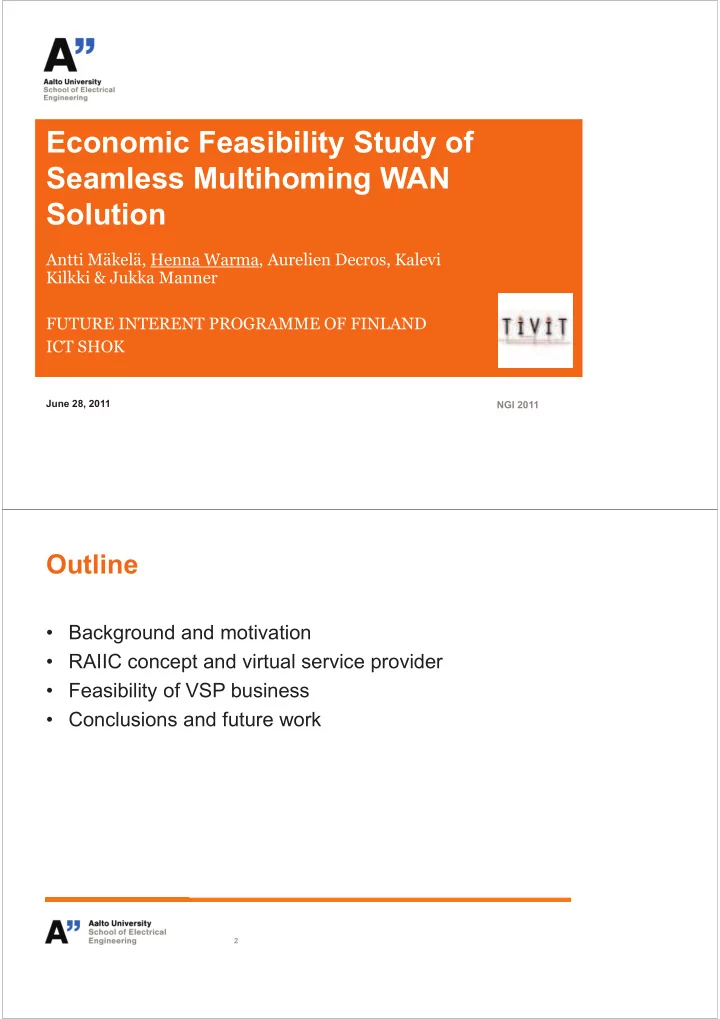

Economic Feasibility Study of Seamless Multihoming WAN Solution Antti Mäkelä, Henna Warma, Aurelien Decros, Kalevi Kilkki & Jukka Manner FUTURE INTERENT PROGRAMME OF FINLAND ICT SHOK June 28, 2011 NGI 2011 Outline • Background and motivation • RAIIC concept and virtual service provider • Feasibility of VSP business • Conclusions and future work 2
Motivation: High reliability is costly • Suppose organization needs intra- site connectivity with high reliability • Some options: – Dedicated connections with redundancy guarantees and Branch Office #1 Service Level Agreements • Expensive – Multihoming via several providers MPLS service provider or Internet • Maintaining own AS number, routing convergence – Multihoming over the Internet using VPNs • Mgmt & Configuration issues Headquarters è Usually very expensive in either Branch Office #2 monetary or workload terms Cost analysis of SLAs 1 Gbps • Example: Finnish medium 1500 € sized company à 10 Mbps 3000 € • Three basic price levels seem to emerge – Consumer-grade – Unguaranteed business-grade – Guaranteed business-grade • Price gap exists between guaranteed and unguaranteed connectivity – Difference may be orders of magnitude – Market situation has remained stable for a considerable period – Global phenomenon 4
High reliability without high costs - is it possible? • Offer a virtual high-reliability bit-pipe over several unreliable connections – Standard consumer Internet connection works ” most of the time ” – Example: three connections with 2 % downtime each • 0,0008 % downtime = 99,9992 % uptime • Redundant Array of Inexpensive Internet Connections (RAIIC) managed by a virtual service provider • Proposed concept implementation is based on Mobile IP with route optimization (Mäkelä, A., 2010) – Could be implemented with other protocols, such as HIP – Simple and low cost infrastructure Mäkelä, A. (2010 ). ” Concept for providing guaranteed service level over an array of unguaranteed commodity connections ” , ACM SAC 2010 5 Mobile IP based RAIIC Virtual Operator Backend Mobile IPv 4 Home Agent AAA and other Services Virtual Operator Cloud Network operator peering point Network Network Network Operator Z Operator X Operator Y Mobile Router A Mobile Router C Mobile Router B Node A Node C Node B Network C Network A Network B 6
How feasible is the concept business-wise? • A new market role – Virtual Service Provider (VSP) • The role of VSP can be taken by – one of the existing stakeholders – a new market player 7 VSP business environment • Several providers for last mile connectivity must exist – Variety in access technologies • Terms of service may disallow to provide consumer- grade connectivity to third parties – Usage of unguaranteed business-grade connections • ISP may proritize their own traffic – Net neutrality legislation – Competition in the ISP market • VSP might have difficulties to become convincing solution – Reference customers 8
SWOT analysis for integrators 9 SWOT analysis for hosting providers 10
SWOT analysis for business service providers 11 Conclusions and future work • There is a need for mid-range priced intranet solutions – RAIIC is a proposal to answer the demand • Multiple outcomes for VSP business establishment exist – Moderately priced option for companies – Co-operation with other market stakeholders • Sustainability of the VSP business can be seen as a threat – Reactions of incumbent providers – Price evolution and increasing competition • First effort of analyzing the economic feasibility of the concept – More detailed analysis on potential target markets – Quantitative cost analysis 12
Questions? Comments? 13
Recommend
More recommend